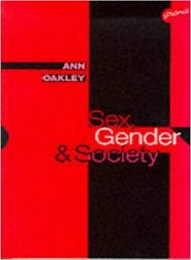
Editor-in-chief: Georges-Claude Guilbert
Book Review Editor: Molly O'Brien Castro
![]()
Ann Oakley, Sex, Gender and, Society (Farnham: Ashgate Publishing Ltd., 2015, 2nd ed.). £22.50, 172 pages, ISBN: 978-1-4724-3562-0—Elise Pereira Nunes, Université François-Rabelais, Tours.
In 1972, British feminist and sociologist Ann Oakley wrote the first edition of Sex, Gender and Society, a pioneer study on the differences between the sexes that questions the impact of biology on the division of gender roles in human societies. To support her argument, she cites diverse sources and fields of research, from sociology and anthropology to psychology; she also gathers acute scientific evidence, statistics and definitions to point at Western societies' patriarchal and binary division of gender roles. Sex, Gender and Society questions biological determinism, which allegedly explains human behavioral differences among men and women as well as women's lack of visibility in the public sphere.
The book is divided into eight chapters, from the evolution of the biological functioning of sexes to the impact of sociocultural context in the construction of one's identity. Oakley puts forward examples taken from other human societies to deconstruct Western societies' nature-based assumptions, and makes a ground-breaking distinction between the terms ‘gender’ and ‘sex’; indeed her publications, when they first came out, were the first ‘to offer a clear definition of sex as biological and gender as cultural.’ [4] This ground-breaking work in the field of gender studies is also to be considered as a testimony fed with feminist theories of the time and major women's liberation movements preoccupied with social and egalitarian issues.
In
the introduction to the new edition published in 2015, she acknowledges
the limits of the previous edition that she sees as a ‘child
of its time’. [3] The idea of a new edition came to her during
a symposium organized in 2013 by the Department of Sociology at the
University of Cambridge devoted to 'Feminist Classics Revisited,'
during which an audience of scholars, activists and students discussed
the impact of her book now regarded as a feminist classic. Oakley
realized her book had become a ‘conceptual tool to help those
engaged in documenting women's oppression’ [10] and decided
to answer one of the most serious criticisms of her work, that which
deplores its limitation to the analysis of white, middle-class, heterosexual
individuals, following binary models. Nevertheless, she didn't intend
to update the book, for it was written to react to the Western societies
of the 1960s and 1970s and must be read as a personal, scientific
and political understanding of the division of gender roles of the
time. She also comments on the need for linguistic and conceptual
clarity to define ‘gender’ limited, so far, to ‘gender
roles.’ [3] She eventually makes several references to American
anthropologist Margaret Mead's Male and Female (1950) as
forming a ‘stout underpinning, along with the work of women
anthropologists, for the argument of Sex, Gender and Society.’
[13]
The introduction to the 1972 edition begins with the widely spread
assumption that men and women are inherently different. Oakley investigates
the extent of these supposed differences and the potential threat
which seems to lay in similarities rather than in differences. She
discusses the examples of the fear generated by Elizabethan women's
independent behavior which would dissolve marital and domestic happiness
[18]; the place of women during the industrial revolution simultaneously
in the home and in the new commercial society where ‘work’
became something divided from ‘family’ [19] and the fear
of the extension of men's rights to women which might fundamentally
change existing definitions of masculinity and femininity. She moves
on to the 1960s and 1970s struggles of the women's liberation movement
with the contemporary trouble when it comes to conventional sex-role
definitions, and establishes that both sexes actually suffer ‘from
a restriction of personal freedom as a result.’ [21] The central
question she intends to answer concentrates on whether the source
of the many differences between the sexes lies in biology or culture,
nature or nurture. She also questions the impact of technology on
our conceptions of masculinity and femininity and states the necessity
to distinct ‘sex’, which refers to biological differences
between male and female, from gender, a cultural and social classification
of individuals into ‘masculine’ and ‘feminine’.
In Chapter 1, ‘The Biology of Sex’ [23] Oakley focuses on human biology and the differentiation of sex such as chromosomes, genes and the reproductive organs; their evolution through the different stages of life (body development, life expectancy, vulnerability, death) and their influence on human behavior. From Oakley's perspective and studies, the belief that emotional instability in women is due to hormonal factors clearly lacks evidence and has contributed to limiting women's role in life and in the public sphere: ‘no one has yet demonstrated a biochemical connection between changing emotional conditions and the physiological changes accompanying the menstrual cycle.’ [40] She then questions research on animals supposed to draw conclusions on female and male humans, a process which commonly reinforces the theory of biological determinism. Indeed, conclusions over the hormonal government of male and female behavior based on animal testing does not appear as relevant when generalized to humans, for the latter have the ability to learn. This statement announces Oakley's main argument, the social construction of masculine and feminine identities.
In
Chapter 2, ‘Sex and personality’, Oakley asserts that
the sex differences can be traced back to childhood and emerge in
the process of cultural learning. She salutes Lewis Terman and Catharine
Miles' work, Sex and Personality (1936), which constitutes
an attempt to establish scientifically norms of femininity and masculinity
in Western societies. [43] After running personality tests on men
and women from different ages, education, measured IQ and social classes,
they concluded that they were indeed behavioral variations between
them that Oakley regards as mainly due to sociocultural factors and
a strong need to conform to one socially visible ideal. Masculinity
is defined and valued by specific behaviors such as aggressiveness,
pugnacity, the ability to lead men more easily than women to criminal
behavior, while femininity is mostly defined in terms of maternity,
domestic matters and expected inhibition of aggression, that is characteristics
received as part of their sex-role training. Women also tend to show
many of the psychological characteristics of minority groups. [58]
Oakley then wonders whether societies other than Western ones make
the same distinctions. She exploits Margaret Mead's anthropological
studies in her work on Sex and Temperament in Three Primitive
Societies (1935) to point out that roles can be reversed regarding
parenthood. Besides, they present different gender roles, definitions
of femininity and masculinity—often for practical, economic
functions—and other stereotypes of masculine and feminine temperament.
Oakley concludes that ‘culture plays an important part in the
shaping of male and female personality, and nowhere is this more clearly
demonstrated than in the cross-cultural evidence.’ [61]
In chapter 3, ‘Sex and Intellect’ Oakley examines the
relationship between children's intellect and their biological sex,
which makes her notice that differences arise among their verbal,
spatial, creative and analytic abilities. [63-65] However, she rejects
the single biological explanations as differences in perception between
males and females appear as ‘small compared to the differences
found between one woman and another and one man and another’
[75] and no universal sex difference in intelligence can be asserted.
She also highlights the strong impact of the children's identification
to their same/opposite parents' roles, leading to Chapter 4, ‘Sexuality’
and her analysis of the functioning of human sexuality.
First, Oakley clearly distinguishes the term ‘sex’ which defines a biological maleness of femaleness from ‘sexual’, for sexuality’ defines a behavior related to copulation. [77] She also asserts that sexuality covers ‘a whole area of personality related to sexual behavior’ and puts forward William Masters and Virginia Johnson's 1954-66 comparative study on human male and female sexual response from a scientific point of view, challenging prejudice over women's alleged passive and submissive behavior in contrast with men's dominant and active position. After the study of subjects' sexual responses which can be divided in four phases—excitement, plateau, orgasmic and resolution [78-79]—they concluded that men and women have the same physiological reactions during intercourse, masturbation or fantasy. Their study follows Alfred C. Kinsey's 1953 ground-breaking research on Sexual Behavior in the Human Female which stated that anatomical differences were not relevant, as man and women have the same system of sensory nerves.
Oakley then discusses the fact that men and women's differences regarding their sexual activity in patterns of experience—such as their home situation and social pressure which highly restrict girls' active sexuality while boys are encouraged to experiment—can even be defined as a ‘deviation’ from the frame of reproduction. She uses Margaret Mead's study of the Arapesh people [83] and Trobriander folklore [85] as proof of variant perceptions of adolescents' sexuality in other societies, and reassesses Western societies' categorization of some sexual behaviors such as homosexuality as ‘deviant’. She eventually supports the theory according to which the differences in the sexuality of males and females can partly be attributed to their anatomies and functioning of hormones, but that the psychologies, personalities and cultural learning processes they are subjected to need to be considered as decisive factors. Freudian traditional psychoanalytic theory is rapidly mentioned (and criticized) as part of the different attempts to explain men’s and women's differences in sexuality. [91] According to this theory, the three characteristics to determine the difference of development of men’s and women's sexualities are the exteriority of male genitals, the female's destiny of motherhood and the structure of the family. She moves on to Kate Millet's work, Sexual Politics (1971), about the different dynamics of power that generate behavioral distortions in order to dominate—which results in men's domination over women in Western patriarchal societies.
Oakley acknowledges the universal division of activities between men and women in every society regarding individuals' sex, generally considered as necessary for survival, but notices variations from one society to another in Chapter 5, ‘Sex and Social Role’. She first focuses on 1960s Western cultures' influence of sex over social roles, resulting in men's appropriation of active, economic tasks, while women are mostly limited to domestic roles due to their responsibility for motherhood. She also laments the low impact of technological advances which were supposed to free women from these limited roles at a time when neither physical strength nor pregnancy and child rearing prevent women from working anymore:
‘Modern medicine and psychiatry provide no data to support the contention that children need their mothers, although there is incontrovertible evidence that children need good physical care, stable emotional relationships, and a certain minimum of verbal and nonverbal stimulation if they are to achieve their human potential. […] The fact that industrialized societies tend to play down the role of the father does not make this a universal human necessity. Motherhood may restrict the social and economic roles of women—but so may fatherhood restrict the roles of men.’ [100]
The
study of other cultures and evidence of societies in which women are
seen as productive and powerful members of society once again validates
the fact that the assignation of gender roles differs from one society
to another and questions the legitimacy of Western societies' cultural
organization of society.
Chapter 6, ‘Sex and gender’ asserts once again the distinction
between ‘sex’ as a biological term and ‘gender’
as a psychological and cultural one. Oakley discusses the wide variation
in the way different cultures define gender and the critical role
played by parents and their expectations in the construction of their
children's gender identity, mostly established in their first two
years (and not from birth). Gender is also performed through a variety
of behaviors associated with either masculinity or femininity such
as mannerism, the way of speaking, the choice of clothes and accessories
or the choice of topics in conversation, as ‘a visible fact
most of the time [while] sex is not.’ [117] The mere possession
of a vagina or a penis—those organs either valued or demanded—as
concrete symbols or masculinity or femininity (instead of male or
female), does not necessary defines one's gender.
She also argues that one's gender is also defined through the amount of femininity or masculinity found in a person, which leads to the case of intersexed individuals, neither strictly identifying with male or female, hence exposing the failure of societies that rely on a strictly binary system of classification and advancing the theory of the possibility of a third sex. Oakley mentions other researchers discussing gender. American psychoanalyst Robert Stoller distinguishes ‘gender identity’—defined as ‘psychosexual orientation’ for sexologists and psychologists Dr. John Money, John Hampson and Joan Hampson—from biological sex in research on intersexuality and transsexuality. ‘Intersexual’ refers to a biological condition while ‘transsexual’ and ‘homosexual’ are gender disorders ‘in the social-cultural acquisition of gender role and gender identity,’ [121] as ‘the homosexual man feels he is male but cannot behave like one erotically,’ as for transsexuals, ‘gender identity and role contradict the variables of biological sex and sex of rearing.’
In Chapter 7, ‘The Learning of gender,’ Oakley focuses on children's learning of gender and the different factors leading to the division between boys’ and girls' social roles founded on their environment, cultural experiences and personal responses to social mechanisms. She discusses Ruth Hartley's 1966 establishment of four fundamental processes to the development of gender roles: manipulation (‘moulding’), canalization (sex differentiated objects), verbal appellation and activity exposure, from the part of adults and parents which vary regarding the children's biological sex. [126] Her study echoes child psychologist Robert R. Sears's works with collaborators on the Patterns of Child Rearing (1957). Oakley also defines ‘imitation’ and ‘identification’ as behaviors related to the ‘tendency for a person to reproduce the actions, attitudes and emotional responses exhibited by real life or symbolic models’ [129] and discusses the impact of gender cultural stereotypes during the age of adolescence, a state of transition between learning, internalizing and performing gender roles.
In the final chapter, “The future of sex differences,” Oakley deplores Western societies' prevailing beliefs that sex differentiation is necessary and that gender roles cannot evolve differently for they are embedded in our biology. She quotes 1960s contemporary gynecologist Edmund Overstreet's work as proof of the difficulties to change male-dominated, conservative society's perspectives, especially regarding women's mainly domestic roles: ‘When you come right down to it, perhaps women just live too long. Maybe when they get through having babies they have outlined their usefulness—especially now that they outlive men by so many years.’ [Man and Civilisation: The Potential of Woman (1963)]. Oakley denounces the persistence of the division of gender roles and the concept of differentiation of sex seen as complementary in order to maintain men's domination and men and women's reproductive roles celebrated through marriage. The importance of motherhood remains strongly influential even if women work, for the positions they occupy fit attributes of femininity (nursing and teaching professions). She eventually applies the ‘separate but equal’ doctrine (referring to racial segregation) to the ‘legal doctrine that sex is a valid basis for classification’ and used to uphold many discriminations, including the exclusion of women from educational institutions and as recently as 1966, from juries.’ [143] This evolution contradicts the modern ideology of equality among members of one society to the detriment of women, thought of as inferior beings and contributes to legitimate 1960s-1970s movements for women's liberation and empowerment.
Sex, Gender and Society successfully challenges essentialist theories on supposedly natural distinctions between men and women and demonstrates that they are finally much more similar than different one from another. The 2015 edition of the book encourages the twenty-first-century reader to consider all the works and advancement on gender studies and biological/sociocultural research that have been conducted since the 1970s; to investigate the social evolutions (if any) of gender roles in private spheres and outdoor spaces; to propose larger discussions on the variation of the performance of gender roles according to criteria such as race or social class; finally to contemplate the idea of a multiplicity of possibilities regarding the construction of the self, if societies reconsider their limiting dual categorization of individuals, one of the purposes of queer studies.
© 2016 Elise Pereira Nunes & GRAAT

Senior
sub-editor: Hélène Tison
lntison@yahoo.fr
Webmaster: Georges-Claude Guilbert

